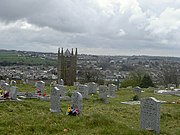
sketchmap showing Phillack's location
Phillack is a village (and formerly a parish) in west Cornwall, United Kingdom. It is situated approximately one mile (1.6 km) northeast of Hayle and half-a-mile (0.8 km) inland from St Ives Bay on Cornwall's Atlantic coast[1]. The village is separated from the sea by a range of high sand dunes known as The Towans.
Phillack has been in the civil parish of Hayle since 1935; before that it was a separate parish in its own right[2]. Phillack parish was originally in Redruth Registration District but the village now comes under Camborne-Redruth Registration District.
There is some dispute over the origins of the name. In the 17th century, Phillack was believed to refer to the Irish Saint Felicitas who is said to have founded Phillack church in the 6th century. However, a 10th century Vatican codex mentions a Saint Felec of Cornwall who is believed to have lived about the same time and may be dedicatee of the parish church[2]
Parish church[]

Phillack church
The church was originally the parish church also of Hayle: it was built in the 15th century and rebuilt in 1856 by William White but the tower is original. The font is probably not medieval; half a coped stone is in the churchyard.[3]
Antiquities[]
Two early stones have been found embedded in the original village church. One bears a 'Constantine' form of a Chi-Rho cross which may date to the 5th century; it was afterwards rebuilt into the wall directly above the apex of the arch of the doorway of the new church. The second is simple memorial stone bearing the name of 'Clo[tualus] [son of] Mo[bra]ttus', dated between the fifth to eighth centuries, and now stands in the churchyard.[4] Arthur G. Langdon (1896) recorded the existence of six stone crosses in the parish, including two in the churchyard.
Notable residents[]
The geologist and philanthropist Elizabeth Carne was born here. The Devon clergyman Richard Carpenter may have been born here in 1575.
References and footnotes[]
- ^ Ordnance Survey: Landranger map sheet 203 Land's End ISBN 9780319231487
- ^ a b [1] GENUKI website; Phillack. Retrived June 2010
- ^ Pevsner, N. (1970) Cornwall, 2nd ed. Penguin Books; p. 141
- ^ See the discussion and bibliography in Elisabeth Okasha, Corpus of Early Christian Inscribed Stones of South-west Britain. Leicester: University Press, 1993, pp. 201-207
External link[]
- "Online Catalogue for Phillack". Cornwall Record Office. http://crocat.cornwall.gov.uk/dserve/dserve.exe?dsqIni=Dserve.ini&dsqApp=Archive&dsqDb=Catalog&dsqCmd=Overview.tcl&dsqSearch=((text)='phillack').
| |||||||||||||||||
| This Cornwall location article is a stub. You can help by expanding it. |
| This page uses content from the English language Wikipedia. The original content was at Phillack. The list of authors can be seen in the page history. As with this Familypedia wiki, the content of Wikipedia is available under the Creative Commons License. |